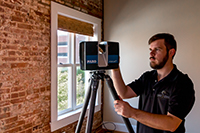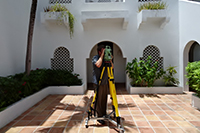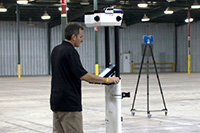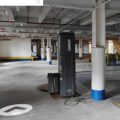Smart Factory Technology is becoming a high priority for industry leaders, as we enter a fourth industrial revolution. The industrial floor of today is quickly becoming a human-machine collaboration with systems that communicate across the enterprise and exchange data in real-time. Seeing every point of the process allows a new level of customization and personalization for customers. It’s a true differentiator and it’s happening – ready or not.
Reality Capture: Smart Factories Made Simple
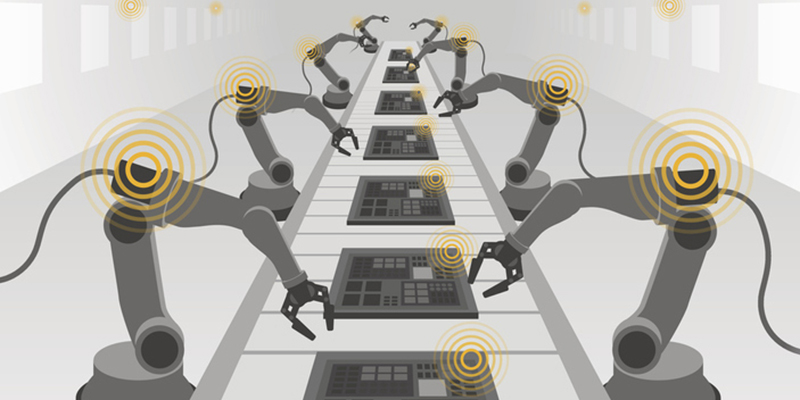
72%
Executives expecting high-level of digitalization within 5 years
91%
Manufacturing leaders investing in Digital Factories/IoT programs
55%
Decision-makers looking to realize ROI within 2 years
The question becomes where to start the Smart Factory transition. Beginning with small incremental steps that increase digitalization within the factory certainly makes sense, but complexities around budgeting, data sharing, compliance, and how to operationalize technology investments create challenges for many companies. Starting with a Reality Capture of your facility helps leaders solve the “complexity problem” of Industry 4.0 project implementation with a digital twin of systems and data from the plant floor.
Go360 Indoor Mapping from Coast 2 Coast combines 3D laser scanning, 360o photography, and collected data to provide a snapshot of the facility layout, condition, and components. Once the simultaneous scan-and-map survey is completed, stakeholders can virtually walk through a digital twin of the space in any browser. This step in becoming a Smart Factory jump-
starts digitalization and helps you visualize and understand what is happening on the factory floor. From there, the collected data, connectivity, and software integration combine into a single view to help forecast potential issues or find possible ways to enhance the efficiency of operations with further steps towards a full factory transformation.
What’s holding back Smart Building Projects?
Corporate Allocation
From Complex:
Quality is reclaiming its place as a key competitive differentiator and sixty-six percent of companies expect Industry 4.0 to result in new revenue streams/business models. Quality professionals must be certain methods are evolving to supply reliable human-machine collaboration and instant performance-based feedback to assure that the organization is measuring the right performance indicators to deliver success.
To Simple:
Knowing what you have in terms of building geometry and equipment can expedite project decision making and implementation for both internal stakeholders and third-party vendors. The Industrial IoT elevates team alignment by connecting data from operations and business systems to help you produce higher-quality products that convert into cost savings that ultimately impact the bottom line.
Communication Silos
From Complex:
IoT Program Leaders often get stuck because of hardware/software compatibility and/or accessibility for the rest of the team. Nearly sixty-seven percent of companies struggle to share key information between departments.
To Simple:
Starting with Reality Capture means you can get raw data for other solutions, a full digital twin to virtually walk through the facility, and even have a platform to view data from sensors. By creating a centralized hub you have the means to visualize software integrations, equipment feedback, and operational capacity in a single view. Streamline communications around improvement potential by narrowing the focus to relevant workflow steps.
Process Changes
From Complex:
An Industry 4.0 company is vertically and horizontally integrated from the C-suite to the shop floor, from planning and design to operations and maintenance, and from supplier to consumer. Changes to the business model must provide new revenue and value-producing opportunities. Roughly eighty-eight percent of companies view the Industrial Internet of Things critical to future success.
To Simple:
Optimize your processes, supply chain management and quality control with advanced analytics from Smart Factory capabilities. Having a view of the facility as it currently exists not only improves simulations by enabling engineers to quickly identify points-of-failure but also improves project visibility to accelerate issue resolution. Resulting improvements in speed-to-market mean quicker returns on the investment.
Compliance Concerns
From Complex:
The significant changes that are occurring in the manufacturing sector have generated a need for a more manageable way to maintain both the facility and the assets. Companies with “smart factory” technology have seen a fifty-three percent increase in real-time asset management and quality control because of the rapid increase of business analytics. From regulatory compliance monitoring to preventing accidents when work is planned in dangerous areas, the foundation for almost any initiative is what’s in place and where.
To Simple:
Using the Indoor Viewer platform makes deciphering regulatory data and managing your company’s insurance and compliance reporting easier because the data is pre-collected and easily monitored. The always accessible online view facilitates property valuation and risk management compliance. Virtual/remote inspections are a pragmatic way to generate environmental and safety reports, asset inventories, and create transparency.
- Budgeting & Prioritization
- Team Collaboration
- Strategic Project Funding
- Operational Alignment
- Camera & Sensor Feeds
- Wi-Fi Mapping
- Communication Silos
The impact of this new age is far-reaching and offers an exciting opportunity for manufacturing innovation leaders, facility executives and engineering/compliance consultants to meet the demands for “smarter” buildings and processes.
You don’t have to invest internal resources to begin an Industry 4.0 factory implementation because we’ve got the tools, the field team, and a diverse array of 2D, 3D and 360º deliverables that not only jump-starts the process but can also be used during each phase.
Smart factories made simple.
- Compliance & Safety
- P&ID Documentation
- Environmental Compliance
- Automation Opportunities
- Simulation Capacity
- Maintenance Questions
- Speed to Market
